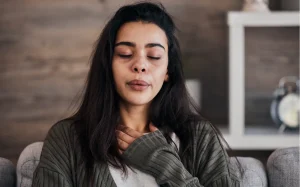ANXIETY DISORDER
ANXIETY DISORDER

Anxiety disorder is a common mental health condition characterised by excessive and irrational fear or worry that disrupts daily life. Symptoms include muscle tension, irritability, insomnia, panic attacks, and irrational fears.
There are various types of anxiety disorders, such as generalised anxiety disorder, panic disorder, phobias, PTSD, and OCD. Treatment options include medication, therapy, self-help strategies, and a balanced lifestyle.
Antidepressants, antioxidants, and anxiolytic properties can aid in managing symptoms. Certain foods, fruits, herbs, and vitamins like magnesium, vitamin A, B12, C, D, E, and zinc can contribute to overall well-being.
Description
Anxiety disorder is a mental health condition characterised by excessive and persistent feelings of fear, worry, and apprehension. It goes beyond the normal feelings of stress and can significantly interfere with daily life. People with anxiety disorder may experience intense and irrational fears or have recurring, intrusive thoughts.
Physical symptoms such as increased heart rate, shortness of breath, sweating, and trembling are common. Anxiety disorder can manifest in various forms, including generalised anxiety disorder, panic disorder, social anxiety disorder, and specific phobias.
Treatment options include therapy, medication, and self-help strategies to manage symptoms, reduce anxiety levels, and improve overall well-being. Additionally, adopting a balanced diet and incorporating foods and vitamins that promote mental well-being can complement treatment efforts.
Anxiety disorders can vary in their presentation and severity. Not everyone with an anxiety disorder will experience all of these symptoms, and some individuals may have additional symptoms not listed here.
- Muscle tension: Muscle tension is a physical manifestation of anxiety and stress. It often leads to muscles feeling tight, stiff, or sore, particularly in the neck, shoulders, and back. This tension can be uncomfortable and may contribute to headaches or other physical discomfort.
- Excessive and intrusive worry about a situation: Excessive worry is a hallmark symptom of generalized anxiety disorder (GAD). Individuals with GAD often experience persistent and uncontrollable worry about a wide range of everyday concerns, even when there is little or no reason to be concerned.
- Irritability: Anxiety can lead to irritability, making individuals more prone to frustration, impatience, and mood swings. They may find it challenging to cope with stressors and may have a reduced tolerance for minor inconveniences.
- Agitation: fast heart rate, sweating, tremors, dry mouth: Physical symptoms of anxiety can include increased heart rate (tachycardia), sweating, trembling or shaking (tremors), and dry mouth. These symptoms are often part of the body's fight-or-flight response to perceived threats.
- Insomnia or sleep problems: Anxiety can disrupt sleep patterns, leading to difficulties falling asleep, staying asleep, or experiencing restful sleep. This can contribute to fatigue and exacerbate anxiety symptoms.
- Panic attacks: Panic attacks are sudden and intense episodes of extreme fear and discomfort. They often involve physical symptoms such as rapid heart rate, shortness of breath, chest pain, and a sense of impending doom. Panic attacks can be debilitating and may lead to avoidance behaviours to prevent future attacks.
- Gastrointestinal disorders: Anxiety can affect the gastrointestinal system, leading to symptoms such as stomach-aches, indigestion, nausea, diarrhoea, or irritable bowel syndrome (IBS). This is often referred to as "nervous stomach."
- Irrational fears: Anxiety disorders can involve irrational or excessive fears known as phobias. These phobias may be specific (e.g., fear of flying or spiders) or more generalized (e.g., social anxiety disorder).
- Feeling restless: Restlessness, or a sense of being on edge, is a common symptom of anxiety. It can manifest as an inability to sit still, constant fidgeting, or a general sense of unease.
- Fatigue: Chronic anxiety can be mentally and physically draining, leading to persistent fatigue. Anxiety can disrupt sleep patterns and increase overall stress, contributing to ongoing feelings of tiredness.
- Heart palpitations: Anxiety can cause heart palpitations, which are sensations of a rapid or irregular heartbeat. This can be distressing but is often a normal response to the body's stress reaction.
There are several types of anxiety disorders, such as:
- Generalised Anxiety Disorder (GAD): GAD involves persistent and excessive worry about various aspects of life, even when there is no clear reason for concern. Individuals with GAD often find it challenging to control their worry, and their anxiety can interfere with daily functioning.
- Panic Disorder: Panic disorder involves recurrent and unexpected panic attacks, which are intense periods of fear accompanied by physical symptoms such as rapid heartbeat, shortness of breath, and chest pain. People with panic disorder may worry about having more attacks and may avoid situations they fear will trigger an attack.
- Social Anxiety Disorder (Social Phobia): Social anxiety disorder is characterised by an intense fear of social situations and a strong desire to avoid them. People with social anxiety may fear being judged, embarrassed, or humiliated in front of others.
- Specific Phobias: Specific phobias are intense and irrational fears of specific objects, situations, or activities. Common examples include fear of heights, flying, spiders, and enclosed spaces.
- Agoraphobia: Agoraphobia involves a fear of situations or places where escape might be difficult or help may not be available, leading to avoidance of places like crowded areas or open spaces.
- Obsessive-Compulsive Disorder (OCD): OCD is characterised by intrusive and distressing thoughts (obsessions) that lead to repetitive behaviours or mental acts (compulsions) aimed at reducing anxiety. These rituals can become time-consuming and interfere with daily life.
- Post-Traumatic Stress Disorder (PTSD): PTSD can develop after exposure to a traumatic event. Symptoms include intrusive memories, nightmares, flashbacks, and avoidance of reminders of the trauma.
- Separation Anxiety Disorder: Primarily seen in children, separation anxiety disorder involves excessive anxiety about separation from loved ones or home.
- Selective Mutism: This is a rare disorder typically seen in children where they consistently fail to speak in specific social situations despite speaking in other contexts.
Anxiety disorders are typically the result of a combination of factors, rather than any single cause. Each individual's experience with anxiety is unique, and the interplay of genetics, environmental stressors, and personal factors can vary significantly.
- Genetic predisposition: There is evidence to suggest that genetics can play a role in the development of anxiety disorders. Individuals with a family history of anxiety disorders may be more genetically predisposed to developing similar conditions. However, genetics alone do not guarantee the development of anxiety disorders, as environmental factors also play a significant role.
- Stress: Stress is a common trigger for anxiety. Chronic or excessive stress can overwhelm an individual's ability to cope, leading to the development of anxiety symptoms or exacerbating existing anxiety disorders. Stressful life events, such as work-related pressures, relationship difficulties, or financial stress, can contribute to anxiety.
- Traumatic situations: Exposure to traumatic events, such as accidents, natural disasters, physical or emotional abuse, or witnessing violence, can be significant triggers for anxiety disorders. Trauma can lead to conditions like post-traumatic stress disorder (PTSD) or other anxiety-related conditions.
- Brain chemistry: Neurotransmitters, which are chemical messengers in the brain, play a role in regulating mood and anxiety. Imbalances or abnormalities in neurotransmitter activity, such as serotonin or gamma-aminobutyric acid (GABA), can contribute to the development of anxiety disorders. Medications that target these neurotransmitters, such as selective serotonin reuptake inhibitors (SSRIs), are often used to treat anxiety disorders.
- Low self-esteem: Low self-esteem and negative self-perception can be contributing factors to anxiety disorders. Individuals with low self-esteem may be more prone to feelings of insecurity, self-doubt, and a heightened sensitivity to criticism or rejection, all of which can fuel anxiety.
- Substance abuse: Substance abuse, including alcohol and drug abuse, can exacerbate or trigger anxiety disorders. Some substances can directly affect brain chemistry and lead to increased feelings of anxiety, panic, or paranoia. Additionally, individuals with anxiety disorders may sometimes turn to substances as a way of self-medicating their symptoms.
- Panic attacks: Panic attacks can be a precursor to the development of panic disorder or other anxiety disorders. The experience of a panic attack, characterized by sudden and intense fear, physical symptoms, and a sense of impending doom, can be traumatic and lead to heightened anxiety in the future.
Medications are often used in conjunction with psychotherapy, such as cognitive-behavioural therapy (CBT), which is an evidence-based approach for treating anxiety disorders.
- Antidepressants (Escitalopram and Duloxetine): Certain antidepressants, particularly selective serotonin reuptake inhibitors (SSRIs) like Escitalopram and serotonin-norepinephrine reuptake inhibitors (SNRIs) like Duloxetine, are commonly used to treat various anxiety disorders. These medications work by increasing the levels of certain neurotransmitters, such as serotonin and norepinephrine, in the brain. By doing so, they can help regulate mood and reduce anxiety symptoms over time. SSRIs and SNRIs are often considered first-line treatments for generalised anxiety disorder, social anxiety disorder, and panic disorder.
- Buspirone: Buspirone is an anti-anxiety medication that is distinct from benzodiazepines. It is commonly prescribed for the treatment of generalized anxiety disorder and may take a few weeks to reach its full therapeutic effect. Buspirone works on serotonin receptors and is believed to have a lower risk of dependency and withdrawal symptoms compared to benzodiazepines.
- Benzodiazepines: Benzodiazepines are a class of medications that can provide rapid relief from anxiety symptoms. They work by enhancing the effects of a neurotransmitter called gamma-aminobutyric acid (GABA), which has a calming effect on the central nervous system. Benzodiazepines can be effective for short-term relief of severe anxiety or panic attacks. However, they are typically prescribed cautiously and for limited durations due to the risk of dependence, tolerance, and withdrawal symptoms when used over an extended period. Common benzodiazepines used for anxiety include lorazepam, diazepam, and alprazolam.
These natural treatment options and complementary therapies can be beneficial for managing anxiety.
- Relaxation and breathing techniques: Techniques such as deep breathing, progressive muscle relaxation, and mindfulness meditation can help reduce anxiety by promoting relaxation and stress reduction. These practices encourage slow, controlled breathing and can be effective in calming the mind and body.
- Psychotherapy: Psychotherapy, also known as talk therapy, can be an effective natural treatment for anxiety. Therapies such as cognitive-behavioural therapy (CBT), exposure therapy, and acceptance and commitment therapy (ACT) can help individuals learn to manage anxious thoughts and behaviours, develop coping skills, and address underlying issues contributing to their anxiety.
- Self-help/support groups: Joining a support group or engaging in self-help resources can provide individuals with a sense of community and shared experiences. It allows people to connect with others who understand what they are going through and can offer valuable support and coping strategies.
- Regular physical exercise: Exercise has been shown to have a positive impact on mood and anxiety. Engaging in regular physical activity releases endorphins, which are natural mood lifters. Exercise also helps reduce stress and promote overall well-being.
- Well-balanced diet: A healthy diet can support mental health. Consuming a well-balanced diet rich in fruits, vegetables, whole grains, lean proteins, and omega-3 fatty acids can provide essential nutrients that support brain function and emotional well-being.
- No smoking: Smoking and exposure to nicotine can contribute to feelings of anxiety and can exacerbate anxiety symptoms. Quitting smoking can have significant benefits for both physical and mental health.
- Avoid alcohol: Alcohol is a depressant and can worsen anxiety symptoms when consumed in excess. Limiting or avoiding alcohol can help reduce anxiety and promote better mental health.
- Reduce caffeine intake: High caffeine consumption can lead to increased anxiety and jitteriness. Reducing caffeine intake or choosing decaffeinated options can help individuals with anxiety manage their symptoms.
- Adequate sleep: Poor sleep can exacerbate anxiety. Establishing good sleep hygiene practices, such as maintaining a regular sleep schedule, creating a comfortable sleep environment, and avoiding stimulants before bedtime, can improve sleep quality and reduce anxiety.
- Yoga: Yoga combines physical postures, breathing exercises, and meditation to promote relaxation and stress reduction. Many people find yoga to be a calming and centring practice that can help manage anxiety.
- Acupuncture: Acupuncture is a traditional Chinese medicine practice that involves the insertion of thin needles into specific points on the body. Some individuals with anxiety have reported benefits from acupuncture, although its effectiveness can vary from person to person.
- Aromatherapy: Aromatherapy involves the use of essential oils from plants to promote relaxation and well-being. Scents like lavender, chamomile, and frankincense are commonly used in aromatherapy for anxiety management.
- Journaling: Keeping a journal can help individuals express their thoughts and emotions, track patterns in their anxiety, and gain insights into their triggers and coping strategies. Writing can be a therapeutic way to process feelings and reduce anxiety.









